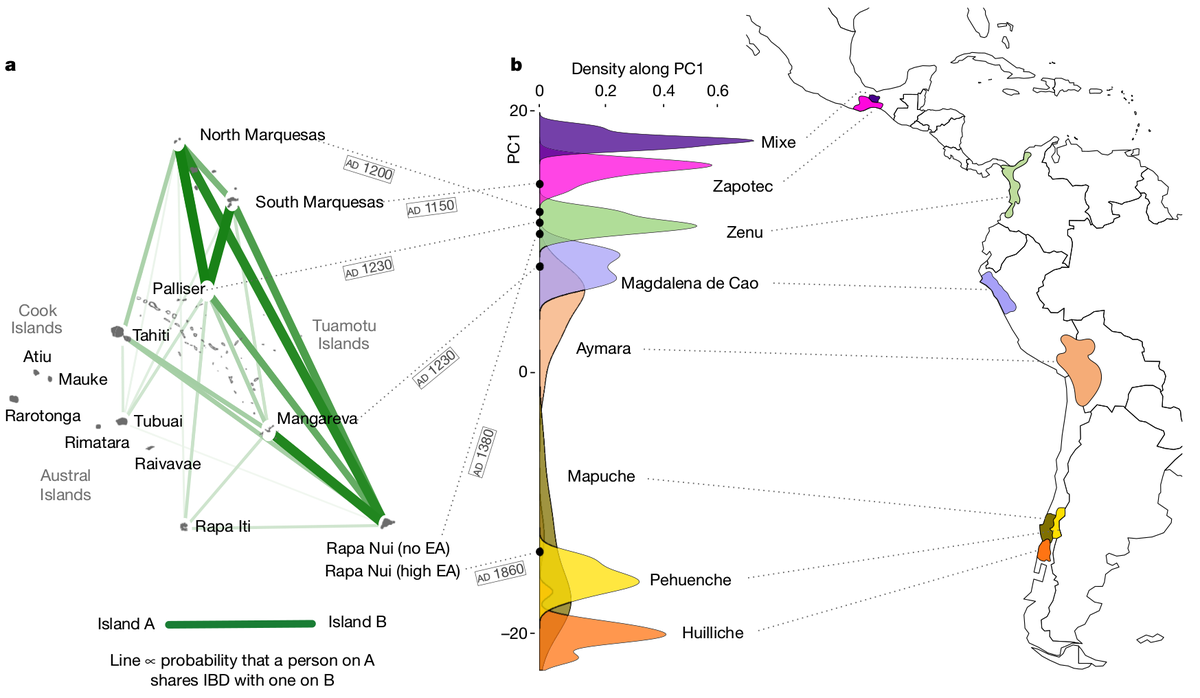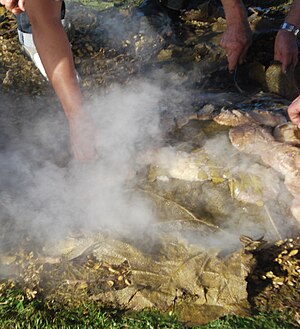@rodriguez
More artifacts such as Ageratum Conyzoides(chick weed), Turmeric, Bottle Gourd and the word stone axe which is Toki were brought by Polynesians to the Americas. The craniometric analysis and genetics also proved that the Polynesians arrived and interbred with Amerindians.
Wikipedia
Pre-Columbian trans-oceanic contact theories - Wikipedia
Claims of Polynesian contact
Ageratum conyzoides
Ageratum conyzoides, also known as billygoat-weed, chick weed, goatweed, or whiteweed, is native to the tropical Americas, and was found in Hawaii by William Hillebrand in 1888 who considered it to have grown there before Captain Cook's arrival in 1778. A legitimate native name (meie parari or mei rore) and established native medicinal usage and use as a scent and in leis have been offered as support for the pre-Cookian age.
Turmeric
Turmeric (Curcuma longa) originated in Asia, and there is linguistic and circumstantial evidence of the spread and use of turmeric by the Austronesian peoples into Oceania and Madagascar. Günter Tessmann in 1930 (300 years after European contact) reported that a species of Curcuma was grown by the Amahuaca tribe to the east of the Upper Ucayali River in Peru and was a dye-plant used for the painting of the body, with the nearby Witoto people using it as face paint in their ceremonial dances. David Sopher noted in 1950 that "the evidence for a pre-European, transpacific introduction of the plant by man seems very strong indeed".
Linguistics of Stone Axe
The word for "stone axe" on Easter Island is toki, among the New Zealand Maori toki ("adze"), Mapuchetoki in Chile and Argentina, and further afield, Yurumanguítotoki ("axe") from Colombia.
Similarity of features
In December 2007, several human skulls were found in a museum in Concepción, Chile. These skulls originated from Mocha Island, an island just off the coast of Chile in the Pacific Ocean, formerly inhabited by the Mapuche. Craniometric analysis of the skulls, according to Lisa Matisoo-Smith of the University of Otago and José Miguel Ramírez Aliaga of the Universidad de Valparaíso, suggests that the skulls have "Polynesian features" – such as a pentagonal shape when viewed from behind, and rocker jaws.
Genetics
Between 2007 and 2009, geneticist Erik Thorsby and colleagues published two studies in Tissue Antigens that evidence an Amerindian genetic contribution to human populations on Easter Island, determining that it was probably introduced before European discovery of the island. In 2014, geneticist Anna-Sapfo Malaspinas of The Center for GeoGenetics at the University of Copenhagen published a study in Current Biology that found human genetic evidence of contact between the populations of Easter Island and South America, dating to approximately 600 years ago (i.e. 1400 CE ± 100 years).
Some members of the now-extinct Botocudo people, who lived in the interior of Brazil, were found in research published in 2013 to have been members of mtDNA haplogroupB4a1a1, which is normally found only among Polynesians and other subgroups of Austronesians. This was based on an analysis of fourteen skulls. Two belonged to B4a1a1 (while twelve belonged to subclades of mtDNA Haplogroup C1, common among Native Americans). The research team examined various scenarios, none of which they could say for certain were correct. They dismissed a scenario of direct contact in prehistory between Polynesia and Brazil as "too unlikely to be seriously entertained." While B4a1a1 is also found among the Malagasy people of Madagascar (which experienced significant Austronesian settlement in prehistory), the authors described as "fanciful" suggestions that B4a1a1 among the Botocudo resulted from the African slave trade (which included Madagascar).
A genetic study published in Nature in July 2015 stated that "some Amazonian Native Americans descend partly from a ... founding population that carried ancestry more closely related to indigenous Australians, New Guineans and Andaman Islanders than to any present-day Eurasians or Native Americans". The authors, who included David Reich, added: "This signature is not present to the same extent, or at all, in present-day Northern and Central Americans or in a ~12,600-year-old Clovis-associated genome, suggesting a more diverse set of founding populations of the Americas than previously accepted." This appears to conflict with an article published roughly simultaneously in Science which adopts the previous consensus perspective, i.e. that the ancestors of all Native Americans entered the Americas in a single wave of migration from Siberia no earlier than ~23 ka, separated from the Inuit, and diversified into "northern" and "southern" Native American branches ~13 ka. There is evidence of post-divergence gene flow between some Native Americans and groups related to East Asians/Inuit and Australo-Melanesians.
In 2020 another study in Nature found that populations in the Mangareva, Marquesas, and Palliser islands and Easter Island had genetic admixture from indigenous populations of South America, with the DNA of contemporary populations of Zenú people from the Pacific coast of Colombia being the closest match. The authors suggest that the genetic signatures were probably the result of a single ancient contact. They proposed that an initial admixture event between indigenous South Americans and Polynesians occurred in eastern Polynesia between 1150 and 1230 CE, with later admixture in Easter Island around 1380 CE, but suggested other possible contact scenarios—for example, Polynesian voyages to South America followed by Polynesian people's returning to Polynesia with South American people, or carrying South American genetic heritage. Several scholars uninvolved in the study suggested that a contact event in South America was more likely.
Bottle Gourd
The origin of the Polynesian bottle gourd (Lagenaria siceraria), an important crop species in prehistoric Polynesia, has remained elusive. Most recently, a South American origin has been favored as the bottle gourd could have been introduced from this continent with the sweet potato by Polynesian voyagers




![[image]](https://archive.archaeology.org/0503/abstracts/thumbnails/canoes.gif)










